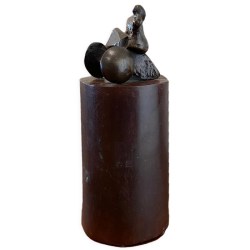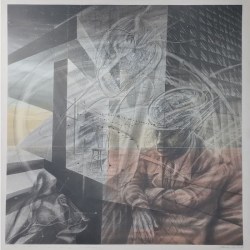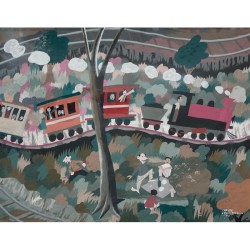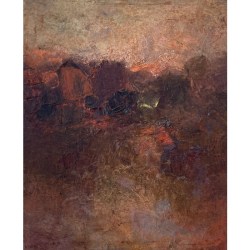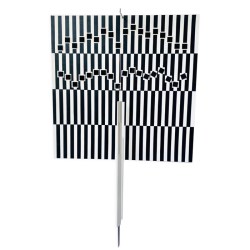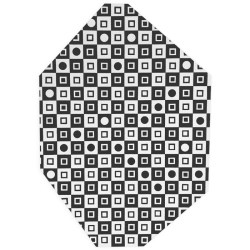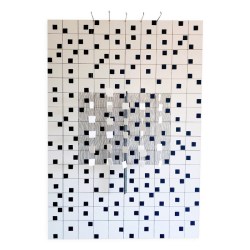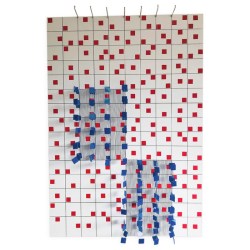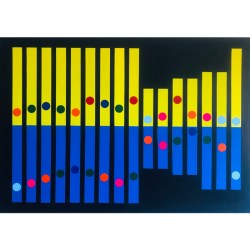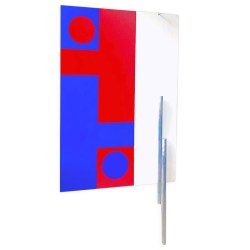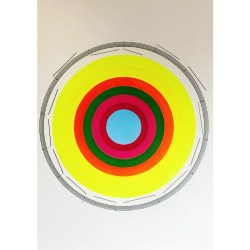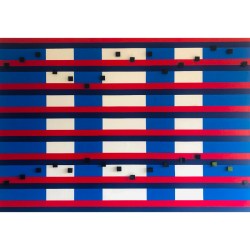Bio
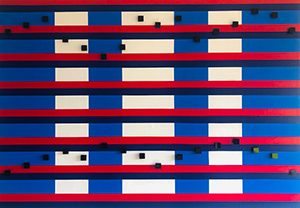
Style and Studies:
Elvis Joan Suárez (1978), kinetic-musical artist. His work focuses on the exploration of color and sound, closely tied to synesthesia, as well as the influence of Venezuelan and Latin American kinetic art, counterpoint techniques, and musical composition, alongside an eclecticism that led him to synthesize various trends, including medieval music, Renaissance music, the archeometer, Le Corbusier's "Modulor," musical serialism, Alexander Scriabin's synesthetic theory, and the construction of Zen gardens.
Elvis Joan Suárez adds another characteristic to kinetic art: sound, providing compositional order through musical counterpoint. However, sound functions not only in terms of synesthetic perspective but also aims to convert kinetic works into musical scores, meaning a kinetic piece that could be performed by soloists or orchestras.
Elvis Joan Suárez defines his artistic style as “neocinetic music.” "Neo" distinguishes the new generation of artists who work and research the precepts of the kinetic movement from the classic kineticism of the 1950s. "Kineticism" is an artistic trend that emerged in the mid-1950s in Paris, characterized by its works presenting real or optical movement in the physical body of the work. "Musical" refers to the inclusion of musical elements such as rhythm, melody, counterpoint, and harmony.
He began his musical studies at the “Miguel Ángel Espinel” School of Music in San Cristóbal, Táchira (Venezuela), studying classical guitar with Rafael Suárez. He took master classes with legendary guitarist Alirio Díaz and prestigious teacher and soloist from the Royal College of Music in London, Carlos Bonell. He attended courses by composer Blas Emilio Aterhortúa. He graduated with honors from the “Vicente Emilio Sojo” Conservatory of Music in Barquisimeto in 2004, with degrees in classical guitar and musical composition. He graduated in music from UPEL and taught composition, music history, and counterpoint at the same conservatory from which he graduated, later at the UCLA University in Barquisimeto (Venezuela).
Work and Career:
His works have been premiered and recorded in various parts of the world. Notably, his “Delta No. 1” premiered in Sydney, Australia, at the “Sydney Guitar Festival” with 27 guitarists arranged in a triangle, conducted by the prestigious guitarist Carlos Bonell. This same piece was performed at the seventh Guitar Festival Shell in the Town Hall Ruins of Darwin. Through Bravo & Music editions, a limited edition of 100 copies of Delta No. 1 was published. The renowned Australian duo Sydney Guitar Duo commissioned him to compose “Las Dos Columnas.”
His Rombo No. 1, commissioned by the “Classical Music Society,” University of Ulster Derry, Ireland, premiered with multimedia projection and performers arranged in a diamond shape. “Mensaje de las Estrellas” is a score inspired by astrology, premiered in the UK at the London International Guitar Festival. He dedicated Circunferencia No. 2 to Xufei Yang. In 2006, Carlos Bonell premiered his “Pasacaglia y Variaciones” at the festival organized by the University Great Hall, University of Ulster. He dedicated “Constelaciones del Norte” to guitarist John Williams.
In the Yamaha Competition in Caracas 2010, his work for Solo Flute Circulo No. 2 was included as part of the competition. In 2007, the Colombian quartet Atemporanea recorded his work: Rombo No. 1, also performing this piece in Buenos Aires, Argentina. Irish guitarist Gary Ryan premiered his “Pasacaglia y Variaciones” at Bolivar Hall in London during the “Transformations Music Series” festival. He composed “Mensaje de las Estrellas II” for Venezuelan guitarist José Luis Lara and dedicated his work “Theotokos” as a tribute to John Tavener for Paraguayan guitarist Bertha Rojas.
In 2013, the Atemporanea quartet from Colombia premiered his work “Homenaje a Taketmitsu” in Bogotá. In 2017, he wrote the piece “Yadekunyawana” for the “Orchestre d'harmonie du Conservatoire de Musique de Strasbourg,” composed on cardboard with gouache, describing the Yekuana universe. His work Delta Modulor No. 10, a woodwind trio with projection, premiered in Strasbourg, France. In August 2018, his work “Cancer” for two flutes was premiered by Celiné Lavenas and Néstor Álvarez at the “Créations et Explorations” festival in Venezuela. That same year, he was commissioned to compose “Círculo Scriabin Modulor” for a clarinet quartet for the French group “Roots 4 Clarinets,” which premiered in France in March 2019 at the prestigious French festival “Musiques éclatées” at the Jean Arp Museum of Contemporary Art.
His work “Melusina” was premiered by flutist Néstor Álvarez and French dancer Salomé Saurel at the Marcel Marceau Cultural Center in Strasbourg in May 2019; this piece is used as part of an educational artistic project in schools in France. In June 2019, his work “Delta Sydney,” for guitar orchestra, premiered with the Sydney Classical Guitar Society, directed by Janet Agostino, as part of a project featuring works directed at cities around the world. The Tehran Contemporary Ensemble commissioned his Mural Kinetic Music dedicated to the great Iranian conductor Siamak Fallahi. In Dresden, Germany, flutist Ruth Pereira premiered his work “Círculo No. 2” at the Goethe Institute along with Néstor Álvarez's “Orfeo & Euridice.” During the “Lange Nacht der Künsten” festival, his piece “Kreis Dante Koyohuuña” premiered at the Japanese Palace in Dresden, commissioned by Ruth Pereira.
Elvis Joan Suárez's visual art has participated in various group exhibitions and is displayed in some galleries in the United States and Venezuela, as well as in private collections. His work Rombo Scriabin was exhibited at the New York art fair Superfineart. In 2021, his works “Círculo No. 2” and his pieces for guitars, Yerma and Theotokos, premiered at the music festival in Reynosa, Mexico, and the Guitarra Almada festival in Venezuela. The prestigious “Tocar y Luchar” competition of the Olivetti Foundation in Germany commissioned two works from him: “Círculos Modulores” for flute and “Circle Le Tombeau Atherhotúa” dedicated to Colombian composer Blas Emilio Aterhortúa, with the latter becoming a finalist. In 2023, the “Jesús Soto” string quartet premiered his work “Círculos Modulores Cinéticos” in Chicago. His work “Counterpoint Black” participated in the Open of San Felipe 2023 in Bogotá at the Casa Debut Gallery.
On November 16, 2023, composer and researcher Rafael Asurmendi defended his thesis on “Neocinetic Music” at the International University of La Rioja in Spain, titled “Synesthetic Kineticism: An Approach to the Visual Music of Elvis Joan Suárez.” The researcher states: “The results of this thesis offer the possibility to discover and explore in Elvis Joan Suárez's synesthetic experience a world full of colors, movement, and music, allowing us to reflect on an unknown territory, leaving a door open for future generations who wish to research this field.”
In November 2024, in Barquisimeto, Venezuela, at the Arte-Espacio gallery alongside the Villandry cultural space, he will hold a solo exhibition with 24 works titled “Kinetic Melographies,” which encompass kinetic and musical content ranging from a melography to a musical spiral, aiming to achieve various interpretations of the same piece, in addition to including premieres of his musical works: “Delta for Three Cellos and Projection,” “Square Modulor for Chamber Group and Projection,” and his performance “Square Modulor Cobalt,” for chamber group and dancer/singer, where the dancer paints a kinetic canvas with her dance and body.
Venezuelan oboist Aquiles Padilla will premiere his work “Círculo Cinético” for oboe in December, based on the archeometer and kinetic technique. At the “Museum Küppersmühle,” considered the largest private museum in Germany, located in Duisburg, North Rhine-Westphalia, where the Ströher collection includes over 6,100 square meters of art, two chamber works with kinetic projections will premiere as part of the event “Zwei Konzerte & Zwei Museum” held in February 2024:
- Kinetic Circles for flute and clarinet.
- Delta for flute, clarinet, and bassoon.
The performers will be Néstor Álvarez, flutist of the Duisburg Orchestra, Xavier Muñoz, clarinetist of the Duisburg Orchestra, and Luis Álvarez on oboe along with German musician Aljoscha Donderer.
In May 2024, he will exhibit in the group show “Geometría Salvaje” at the prestigious Adrian Ibañez Gallery in Bogotá, premiering three works for clarinet and horn:
- Modulor Circle Bogotá.
- Kinetic Modulor Circles with Porro.
- Random Rectangles Cobalt.
Opinions:
“Elvis Joan Suárez takes this to the extreme: his scores are abstract paintings; the musician interprets what he feels when looking at these images. It is a rejection of understanding art as a calculated and serene creation by a genius, where intuition also plays a fundamental role in the visual arts.”
— Museum Küppersmühle, Germany.
“Suárez seeks synesthesia in his works, placing sound tubes refined with precision to evoke color alongside sound.”
— Contemporary Gallery Asheville, North Carolina, USA.
“His works of art, with the mathematical precision of music, are beautifully classical. Elvis Joan Suárez is a Renaissance man in the 21st century, and through his works, he sends light and talent to the entire world.”
— Carolina Jaimes Branger, El Universal, Caracas, 2019.
“He devised a way to interpret musical works accompanied by artistic designs from the kinetic movement, a trend that has been termed neocinetic music.”
— El Estímulo, 2020, Information Portal, Venezuela.
“Elvis Joan Suárez is one of the most original and innovative composers and visual artists that Venezuela has produced in recent years.”
— Roberto Palmitesta, Venezuela Sinfónica, 2019.
“A wonderful composer, deeply spiritual in the tradition of Arvo Pärt and John Tavener, yet he gives a completely personal touch to his music. Very visual as well in his concepts.”
— Carlos Bonell, guitarist and director of the London Guitar Festival.
“Here at the City of Derry Guitar Festival, we always seek to commission music for guitar from composers with imagination, creativity, and who think outside conventional composition guidelines; Elvis Suárez embodies all these characteristics. His innovative and imaginative music is at the forefront of modern composition. We greatly enjoy performing and premiering his music.”
— Sean Woods, guitarist and director of the Londonderry Guitar Festival, Northern Ireland.
“The music of Elvis Joan Suárez is very spatial; since we heard his Delta No. 1, we were impressed and commissioned him for Delta Sydney for guitar orchestra.”
— Janet and Raffaelle Agostino, Classical Guitars, Sydney.
“The contribution Suárez makes, using music and visual art as a visual channel for his work, which through color and movement creates a connection with emotion and the senses in a kinetic-synesthetic proposal, as the composer himself has called it: neocinetic music.”
— Rafael Asurmendi, music researcher and composer, The Wynwood Times, Miami, USA.


